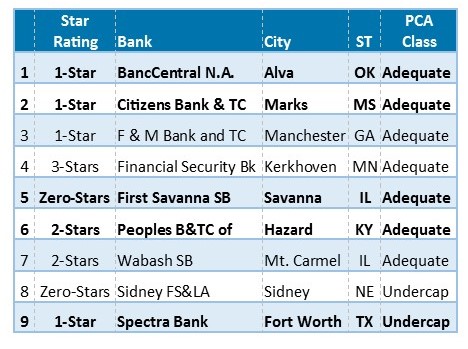The percent of recommended banks (rated 5-Stars or 4-Stars) remained virtually unchanged between Q4’2021 and Q1’2022. However, banks earning Bauer’s top rating (5-Stars) are at their lowest level since 2018. Problematic banks (rated 2-Stars or below) while still low (1.05% of banks), ticked up for the first time since Q3’2020.
In aggregate, first quarter 2022 net income fell by 22.2% from a year earlier. Why? Loan loss provisions were up. Loan loss allowances now represent 1½% of total loans and 184% of noncurrent loans and leases. That was aided by a decrease in noncurrent assets plus other real estate owned (repossessed) which were down to 0.41% of total assets (from 0.57% a year ago).
The largest decline in noncurrent loans came in the single (1-4) family home sector, which was down 10½% in the quarter. That was followed by Commercial Real Estate, (CRE) which was down 2.8%.
But, while industry noncurrent loan balances declined (down $4.5 billion or 4.5% from Q4’2021), nearly 45% of banks did not share in that good fortune.
Other bright sides reported by the industry as reported on the FDIC’s Quarterly Banking Profile, include a 31% drop in credit card charge-offs and a 58.7% drop in Commercial & Industrial Loan charge-offs. Overall, net charge-offs to loans and leases dropped from 0.34% a year ago to 0.22% at March 31, 2022.
The average leverage capital ratio (CR) was down 7 basis points (bps) from year-end 2021, and risk-based CRs were down 40 bps. Even with these declines, though, the averages remain above pre-pandemic levels.
Three new banks opened during the first quarter. They are:
3½-Star Locality Bank, a digital-first community bank, opened in Ft. Lauderdale, FL after a $35 million capital raise.
3½-Star Scottsdale Community Bank, AZ, became the first Arizona de novo since 2007.
And, with initial capital exceeding $32 million, 3½-Star EntreBank, Bloomington, MN, became the first Minnesota de novo in 14 years.
Now, the “not so bright” news. The 45 banks listed on page 7 are on our watch list for nonperforming loans. Each has high delinquencies (represented by either a Texas Ratio of 50% or higher and/or a Bauer’s Adjusted Capital Ratio (CR) of 3% or lower) and/or a nonperforming asset ratio of at least 1.5% AND loan loss reserves to cover only 80% or less of those nonperforming loans.
3-Star Cross River Bank, Fort Lee, NJ, for example, with total assets of $8.9 billion, has a leverage capital ratio well over 14%. That is a little lower than at year-end 2021, but still impressive. However, nonperforming loans skyrocketed during the first quarter. Its Bauer’s Adjusted capital ratio dropped from 14.47% at year-end to 5.61% at March 31, 2022 while its Texas Ratio went from 3.5% all the way up to 61%. Similarly, nonperformers as a percent of assets jumped from 0.55% to 9.24% and loan loss reserves don’t even cover 10% of them should they all default.
We don’t usually see that degree of deterioration in one quarter. Most problems arise more gradually, like 2-Star Monterey County Bank, Monterey, CA. In this instance, Bauer’s Adjusted CR has only reached 2% once in the past year and the Texas Ratio has not been less than 73%. This is the first time it has exceeded 100%, though. Monterey County has enough reserves to cover less than 42% of its nonperforming loans.
Only one of the page 7 banks is less than Adequately-Capitalized by regulatory PCA standards. That distinction belongs to the $88.5 million asset 1-Star Spectra Bank, Fort Worth, TX. With a leverage CR of just 3.1% and risk-based CR of 6.7%, it’s easy to see why. Its Bauer’s Adjusted CR dropped from 3.1% last quarter to just 0.5% today. While its Texas Ratio remains below 50% (48.5%) it is up from 10.6% year ago and 39% last quarter.
Actually, only nine U.S. banks are less than “Well-Capitalized” by those PCA standards (up from 7 last quarter). Five (bold) are on page 7.



